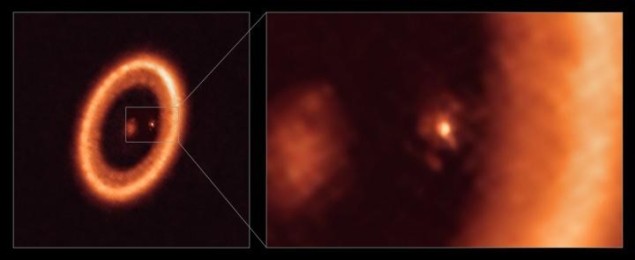 Myriam Benisty, who is at the Universities of Chile and Grenoble. The discovery could lead to important insights into how moons and planets form and evolve within young star systems.
Myriam Benisty, who is at the Universities of Chile and Grenoble. The discovery could lead to important insights into how moons and planets form and evolve within young star systems.
The discs of gas and dust surrounding young stars often have rings, gaps, and spiral arms that are carved out by newly forming planets. These planets can also acquire discs of their own, and astronomers believe that moons can form in these discs, carving out their own rings and other structures. So far, however, this process has never been observed directly.
In 2018 and 2019, the ESO’s Very Large Telescope (VLT) made the first observations of two exoplanets yet to fully form, through direct infrared images of the disc surrounding PDS70. Since then, the giant, Jupiter-like planets have been observed using a variety of other techniques. Among these were observations of hydrogen-alpha light emission, which only occurs in regions where hydrogen is being ionized. This suggested that the planets were still accreting material.
Cool dust grains
In their study, Benisty’s team present the latest observations of PDS70 by ALMA, which can pick up millimetre wavelengths emitted by cool dust grains. With resolutions as high as 2.3 au (Earth-Sun distances), the ALMA’s images clearly show a disc surrounding the outermost exoplanet, PDS70c, with an outer radius no larger than 1.2 au.
Depending on the size of the dust grains, the researchers reckon that the disc could contain anywhere between 0.7% and 3.1% of Earth’s mass – enough material to form up to three satellites with similar masses to Earth’s Moon. In addition, the material in PDS70c’s disc is well within the radius where it would be retained by the exoplanet – providing ideal conditions for a moon to form.
Starved of dust
The innermost exoplanet, PDS70b, did not display any clear evidence for a circumplanetary disc. According to Benisty’s team, this could mean that the planet has a far smaller radius within which orbiting material can be retained. Alternatively, it could have been starved of dust grains by PDS70c, whose orbit is better placed to access material within PDS70’s circumstellar disc.

Planet-forming disc is torn apart in triple star system
Further observations of the system offer astronomers a unique opportunity to study the formation of planets and moons through direct images – and this could improve our understanding of how moons form around young gas-giant planets. Benisty and colleagues now look forward to exploring the system in more detail using the ESO’s upcoming Extremely Large Telescope (ELT), which is currently under construction in Chile and should switch on in 2027.
The research is described in The Astrophysical Journal Letters.
